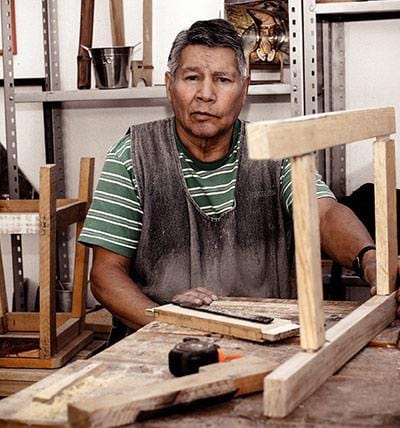They say that diamonds are a girl's best friend. Well, today we're gonna show you that you don't have to spend thousands of dollars to win a place in her heart. In fact, you can do it by building a beautiful wooden jewelry box for her to store the jewelry she already has. We're throwing another log on the fire for this project, and it's gonna get a little bit challenging. It's gonna require quite a few tools and a little bit of

Woodworking knowledge to knock this out, but if you're willing to put in the time, you can get some beautiful results. So to get started with this project, the first thing we need to do is mill up some lumber. So we take some walnut over to the jointer to clean it up, and then we're resawing it in half so I can end up with some thinner panels.
Then you can take it over to the planar and plane everything down to a uniform thickness. So from there, we're gonna be making a bunch of jewelry box joints to lock all the pieces together. And the way we're gonna do that is to take it over to our router table and use this box joint jig to make a bunch of interlocking box joints that will act as all the sides for the box.
We're also carving a little dado in, so we can slide in both the top and the bottom pieces of the box. We didn't want the dados to go all the way through, so we had a little stop setup on the router table, and then we could just clean up the rest of it with a chisel. From there took a piece of walnut over the table saw and cut the piece that would be the bottom panel of the box. Next we can move on to making the top panel of the box. Now for the top panel, we wanted it to be a little special, as it is for her favorite wood jewlery and necklaces, so I picked up a piece of zebra wood and then we ran that over to the jointer to get a nice flat edge.
And then we resawed it on the bandsaw, so that we can fold it in half and create what's called a bookmatched panel for the top. Bookmatching means that when you flop it open, you basically have the same brain pattern alternating on each side, so it looks like you're opening the page of a book with the same pattern on both sides. So once you fed the pieces through the planer to get 'em to the uniform thickness that you needed, then you could glue 'em up to create one large bookmatch panel. Once the panel had set up and dried, you could take it to the table saw, cut it down to the size that you needed. So once the piece was cut, you could slide it into the dados that you created and then put the box all together. Once you dry fit it and made sure that everything fit properly, then you could start gluing it up. Now we're gluing it together and it's gonna be one solid thing with a top and a bottom. Then, once it's all set up, that's when we'll cut it to create the lid and the bottom.
The bottom panel sits in this little rabbit that we carved on the router table when we were cutting all the pieces earlier. It just slides right into place, we glue it in place, and then put some weight on it to hold it down. The fingers of the box joints are a little bit proud of the rest of the box and that's intentional. You wanna be able to use a flush trim saw to cut the fingers back so that they're flush with the rest of the box.
You never want 'em to be too short because then you have to fill in those gaps, So we're using a flush trim saw to trim off the excess, and then we'll just go in and clean up the rest of it with an orbital sander. Now that the box is all together, you could take it over to the bandsaw and cut the lid off. This part is always a little bit nerve wracking, because you never wanna screw up the box. So you just gotta make sure to take your time, make sure you're getting a nice clean cut on the bandsaw. Then you can mount a piece of sandpaper to a block or something and make sure that everything is square and that your cut lines up nicely.
From there, we're gonna start laying out the hinge hardware and the clasp on the front of the box. With all the rough assembly complete, then we could apply the first of many coats of finish. From there, we could start working on the compartmentalized insert for the inside of the box. We decided to use some more zebra wood to match the outside of the box, and it's gonna look really nice along with this walnut.
I notched the inside pieces so they overlapped each other to create a crossing pattern, which locked everything together nice and strong. Then, you could just sand it down and apply a few coats of finish to that. And then before you final assembled everything with the hardware, use a piece of peel and stick felt as the bottom of the box, then put everything back together, installed the hardware, and this project is finished. So that's it for this project. We hope you guys enjoyed reading about it, and we hope you learned something. Now if you make a box like this, be sure that whoever you're making it for is gonna absolutely love it, and you can gift it for generations to come.
ABOUT THE AUTHOR
Aleksandra Djurdjevic
Senior Content Creator
Aleksandra Djurdjevic is a senior writer and editor, covering jewelry, accessories, and trends. She’s also works with services, home décor. She has previously worked as ESL teacher for English Tochka. Aleksandra graduated from the Comparative Literature department at the Faculty of Philosophy in Serbia. Aleksandra’s love for the environment, crafts and natural products over the years helps her continue to be a top expert at Wooden Earth.






